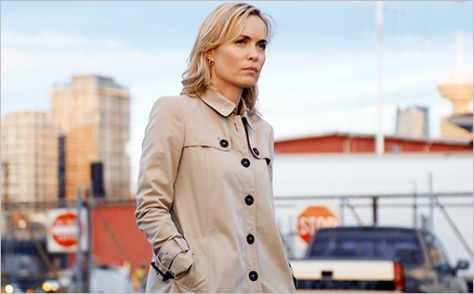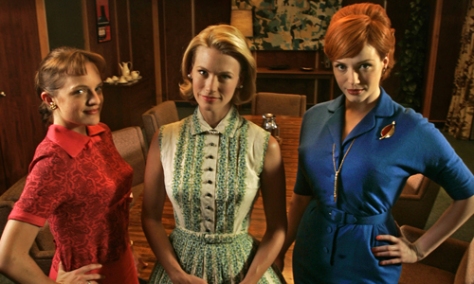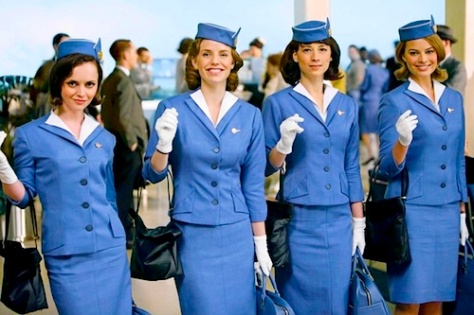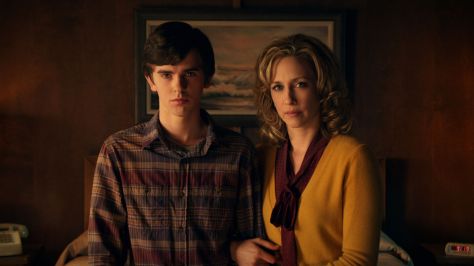Drama for Broadcast Television’s Future (Written March 2013)
“You clearly don’t know who you’re talking to, so let me clue you in,” says Walter White to his concerned wife. “I am not in danger. I am the danger.”
In the sixth episode of Breaking Bad’s fourth season, Walt leaves his wife in paralyzed terror after he steams out the secret he has keeping from her—revealing to her just how powerful and threatening of a position he holds in his in his illicit methamphetamine business. Walt is no longer vulnerable to the authorities of the dangerous industry he had stumbled into—this industry has become subjugate to Walt. A high school chemistry teacher became so powerful how? Because he cooks the best crystal meth. The show’s home network, AMC, could say the same for itself in the ruptured future of television.
The past month has proven one of the worst ever for mid-season premieres on broadcast networks. Taking the hardest hit, NBC averaged a 1.2 rating, a record low coming in below below Univision’s 1.5. If that weren’t embarrassing enough, it also broke a record for the lowest-rated broadcast drama premiere—Ever. “Do No Harm” opened to just 3.1 million viewers and a 0.9 rating. It’s not alone in facing cancellation—NBC is snuffing out its new shows like a CBS “Survivor” marathon. Not without reason—these are not good shows, but with “30 Rock” and “The Office” ending and few dramas being renewed, NBC is at risk of losing primetime shows that remain identifiable to its long-lived brand shaped by comedy hits like “Seinfeld” and “Friends” and dramas like “Law and Order” and “ER”. Hopefully, the struggle will be taken as a seriously needed opportunity for the broadcast network to begin anew.
ABC, while holding on to a few of its reasonably successful women-centric dramas (i.e. “Scandal” and “Grey’s Anatomy”), faced a similar disaster with its mid-season premieres last month. “Zero Hour” premiered to a 1.3 rating, which was the lowest in ABC history, followed by the two-hour premiere of “Red Widow” which nearly matched it coming in with a 1.4 rating. “Zero Hour” has been cancelled and “Red Widow” is on the edge with an uncertain future.
What’s wrong with these shows? I watched “Red Widow” as something of a quick case study in understanding was going wrong with these pilots. “Red Widow” was an all right ABC drama pilot I thought. In the first hour, a San Francisco mother is faced with the murder of her husband just before he makes his move to exit his involvement in the cocaine trade—against her will, the mother is going to have continue her husbands illicit line of work in order to protect her family. “Kind of like Breaking Bad!” I thought, but with a woman because it’s ABC… and a first couple seasons-worth of character development condensed in one episode because it’s broadcast. Although “Red Widow” was adapted from a successful Dutch drama “Penoza”, the show’s writer Melissa Rosenburg has answered a question of “Breaking Bad” influencing her adaptation in an interview: “If I can emulate it in any way, I would,” she says. “They set the bar very, very high and it is certainly the model for it, absolutely”. Knowing the kind of immoral crimes Walter White comes to commit in later seasons and the lack of complex relationships introduced in this pilot, I question whether Rosenburg will be able to emulate “Breaking Bad” in an effective way on broadcast television. This show, despite its successful influencers, will not be benefitting its network in any way similar.

When a show breaks out that does something new and does it very well, it has a great influence on the pilots that will be ordered in following season. “Breaking Bad” is not AMC’s first show with such influence on shows developed for ABC. AMC’s first success in drama is acclaimed “Mad Men” which centers around an advertising agency on Madison Avenue in 1960’s New York City. In 2011, ABC premiered its drama “Pan Am” centered on four flight attendants flying in and out of 1960’s New York City. The show performed okay in its first few weeks, but quickly dropped ratings and was cancelled. If ABC hadn’t learned a lesson in emulating AMC then, maybe it has now. They’ve had the wrong idea of what it is that makes these shows successful. ‘1960’s’ and “New York City” didn’t become key ingredients to a successful show. Nor, now, have “desperate parent” and “coercive drug trafficking” become key ingredients. It isn’t about creating a match of AMC’s subject matter; it is about matching the way in which AMC makes it happen—originality and risk required.


The Revolution Was Televised: The Cops, Crooks, Slingers and Slayers Who Changed TV Drama Forever is a book by Alan Sepinwall that describes how dramas evolve from one game-changing show to the next. The last and most recent of the twelve revolutionary shows Sepinwall identifies are “Mad Men” and “Breaking Bad”. Sepinwall gives us insight to the conditions at AMC to first create a show like “Mad Men”. AMC CEO Josh Sapan approached executive Rob Sorcher with this demand: “We need a Sopranos.” Sapan hoped to move the cable channel from airing only ad-supported movie classics to introducing its own original programming. Sapan was worried that AMC was in a bad position to remain a necessary part of the cable package while standing vulnerable without affiliation to large cable empire empires like Viacom. Comcast could easily launch their own movie channel with offerings above AMC’s second-tier movies. “My boss [had] told me that ratings, in that moment, don’t matter,” said Schorcher. “What AMC needs is a show, a critically-acclaimed and audience-craved show that would make us undroppable to cable operators.” Schorcher and Sapan tested the waters with an original movie first. A Western, “Broken Trail”, was selected to match a genre that was most popular amongst their classic offerings and was considered a success. In choosing a series to continue original programming, they decided that to simply match a genre from their library again would not give them “something of real distinction and quality.” A smart script that had been deemed unmarketable, “Mad Men” was chosen.
The first season averaged less than 1 million viewers weekly, but received the acclamations it had hoped for. The executives noticed a quick increase in time-shift viewing and that it quickly became the networks “greatest friend” Charlie Collier, the network president, said. “We had a show on a network that people didn’t know to come to for scripted dramas.” The show was offered for catch-up viewing by means of DVR, DVD, On-Demand and online streaming services each and in each returning season the live ratings increased—the latest season premiered to an audience of 3.5 million, more than 3 times their first season average.
AMC followed this model again with “Breaking Bad” which became another slow-grown success as a result of time-shift viewing. My personal viewing habits reflect the effectiveness of this strategy. I had never had access to AMC’s cable service, but had binged on the first three seasons of “Breaking Bad” on Netflix after hearing friends rave about the show. As the fourth and fifth season premiered, I bought Season Passes on iTunes. I recommended the show to my parents who, rather than watch online or pay more for premium cable package, bought the first two seasons on DVD. A quick search online now, I could access the show with a Netflix subscription of $8.99 a month, on YouTube for $1.99 per episode, on iTunes for $2.99 per episode or in a variety of Season Pass packages incentivized by original webisodes, deleted scenes and behind the scenes content. I could download episodes or order the DVDs on Amazon or I could watch on Xbox Live. The show is certainly made available to anyone who wants to get started, catch-up, or re-watch the series in time for this summer’s premiere of final episodes—guaranteeing “Breaking Bad” to have its highest ratings yet.
The most successful show at AMC yet has been “Walking Dead”. Which in this most recent week (ending March 10) topped cable ratings with 10.458 million same-day viewers. This number of viewers would rank within the top ten list in viewership on the broadcast list—only coming in below the several top shows of CBS and FOX’s “American Idol”. This is significant considering NBC’s shows are nowhere in the top lists. “Walking Dead” is not the only cable show bringing in these broadcast-level ratings this week—History channel’s “The Bible” was received by 10.8 million viewers and A&E’s two episodes of “Duck Dynasty” was received by 8.2 and 8.1 million viewers—coming just below ABC’s highest rated of the week, “The Bachelor”, with 8.5 million viewers.
AMC’s top three shows have risen to become some of the most talked-about shows on television. This is because these shows feature three distinct and different story worlds—1960’s Madison Avenue, New Mexico drug trade, and a zombie apocalypse. In competition against broadcast dramas, which alternately order and schedule shows similar to their current offerings in order to continue flow and hold viewers through the primetime hours, the cable networks have grown shows out of the need to distinguish their networks.
While the shows like “Walking Dead”, “The Bible” and “Duck Dynasty” are celebrated among the highest rated on cable this week—it’s also true that their networks are not necessarily receiving as high of ratings on their other offerings. The shows attract large audiences because of the complex characters involved—the universalities of the stories take place in unique settings with definitive themes. Viewers who hold particular interest in the subject matter or themes presented in the show may be drawn in by the other programming offered on these networks. For example, AMC hits were grown from the niche audience of “classic movies”, The History Channel from an audience valuing historical knowledge, and A&E which (since leaving its prestigious “Arts and Entertainment” origins behind) has grown as a place to host quick-fix reality shows—that now premiere on primetime nights filled by single shows like “Duck Dynasty” and “Storage Wars” for binge viewing. These hits promote their networks on smaller scales, but it remains significant that the cable hits are competing with the hits of broadcast.
There is a serious change happening in the usual differentiation between broadcast and cable ratings. Broadcast continues its history of shows designed for the “greatest common factor” of audience interest and has given them top-rated viewership while the expanse of cable networks worked to create shows catered to niche demographics and interests. Now, however, the top ranking shows of broadcast are being challenged by the rise in ratings of cable successes. Cable networks no longer stay confined to one format or type of show either. AMC has moved to distinct reality show programming such as “The Pitch” and “Freakshow”—following their brand theme of shows that are smart and abnormal. Even A&E is about to the enter the world of scripted drama with “Bates Motel”, a “Pyscho” prequel about the murderous and lightly incestuous mother-son duo, that will likely continue to represent the network theme of unusual but important family values from which “Duck Dynasty” has grown. Creating shows for broadcast networks is now the toughest job, when ordering shows for the broadest audience possible and continuing programming flow from current shows clearly oppose the need to create shows that are both distinct and remarkable.

Remarkable is an important word that stuck in my head last year when my boss at a start-up was sneaking me into private speaker events for employees at Google. One week, Seth Godin, an author, speaker and advertising/marketing expert, was giving a presentation in which he explained that the approach to every advertising spot today absolutely needed to be making it “remarkable”—“As in worth making a remark about.” His point was that traditional campaigns are becoming practically useless while creating word-of-mouth and digital shares have become the most effective methods of attracting consumers. In terms of TV shows, successful ratings don’t grow unless there is something to be talked about after a viewing or a way to talk about it. With these pressures to distinguish themselves, cable networks are the ones today that make TV show experiences worth making remarks about, but “remarkable” content is also appearing from a new batch of creators—the third and newest competitor in television: anybody. In the online world of viral videos as a result of easy digital sharing, one could recognize that thriving networks like AMC operate much more like the Internet than they do a cable channel. Marketing efforts don’t grow an online hit, the audience does when they share it.
Chris Anderson’s book “The Long Tail: Why the Future of Business is Selling Less of More” explains the trend as it pertains to every industry affected by the relatively new access to niche content on the Internet. Entertainment industries previously held power by means of “limited shelf space”—as in only so many top-selling books on a Wal-Mart shelf, only so many top-rented VHS and DVD’s fit into a Blockbuster, and only as many TV shows as primetime blocks and networks. The “Long Tail” refers to the niche content previously lacking distribution means to reach an audience of too specific and therefore, too few, consumers. The first challenge to broadcast networks “hit market” were cable networks—rather than a few broadcast channels, viewers have a remote control and the ability to select from one to two hundred channels with a premium cable package. The limitations of shelf space expanded but only in the comparison of choosing to go to a Barnes & Noble store for a broader selection of books than the top-sellers you have found at your local to a Wal-Mart. Now consider the choices made available for readers at a Wal-Mart or Barnes & Noble as compared to books on Amazon.com. EVERYTHING is available and in any form—hardcover, paperback, e-book, and on your laptop, e-reader, tablet, or smartphone. Shelf space restrictions have disappeared completely in online markets. The solution, Chris Anderson gives to businesses struggling to compete amongst the explosion of all this niche content is to “1) Make everything available” and “2) Help me find it”.
Not everyone can be Amazon, but a serious threat to the traditional broadcast and cable bundle is the growing competition to become the go-to online distributor who can make all video available and help consumers navigate it in regards to their niche interests. These are reasons for such companies as Netflix, Hulu, Amazon, and YouTube, but also their reasons for pursuing original content to be free from licensing restrictions. New companies have everything to gain in entering content streaming, while traditional broadcast networks and the cable networks linked to their corporations are in an inherently bad position to release their content to streaming distribution.
Broadcast channels have managed to position themselves to keep the greatest profits from cable subscriptions even though they were originally created as free signals. Their profits today must be coming from the fact that they are sold to bundles as the most valuable part of cable package—even though they should or could be free. Huge profits are made for broadcast networks by overcharging consumers for more content than they actually consume. At the same time, consumers are finding a cable package less and less valuable, while knowing they don’t watch most of the 200-300 channels they are paying for (and from which broadcast is overpaid). Consumers are tempted to spend their money more efficiently to pay only for what they actually watch as more quality content is made available independent from a bundle online. Even if broadcast were to unravel the bundle of channels and shows from the bundle into a la carte offerings of smaller or individual channels, in attempt to keep cable subscribers—they will inevitably lose money. Therefore, broadcast networks can only lose in an unbundled future and every reason to keep it together as long as they possible can.
Meanwhile, cable networks like AMC operating without affiliation to the predominant corporations tied to the traditional bundle have been in the best position to follow the advice of Chris Anderson. With nothing to lose, AMC has been able to make its shows available to anyone who wants to watch, helping them discover it by hosting it on a variety of streaming services and incentivizing payment with a variety of formats and price points. This is the key to success during the forthcoming unbundling of television. Without being held down by major corporate affiliations to a declining industries, networks like AMC that don’t have these investors to answer to can dip into the best of both worlds with audiences watching on cable and online.
All hail the king. AMC has managed to provide “king” content and grow audiences with accessibility while other networks are held back by creative and corporate restrictions. Digital distribution moves by new streaming companies are all focused on providing great content—think of Amazon Prime’s purchase to exclusively release “Downtown Abbey” or Netflix’s original “House of Cards”. Serious digital moves only happen with great content.
Hollywood Reporter writer Tim Goodman gives NBC entertainment chairman, Bob Greenblatt, some advice in an article titled Can NBC Save Itself From Being NBC? Goodman claims that Greenblatt’s termination is inevitable because investors will not be pleased no matter what. Goodman’s advice for Bob? “Look at the number around you –not just NBC’s numbers (don’t stare at those!) but those of ABC or Fox or The CW. Do you know what those numbers are, Bob? They’re cable numbers. So be a cable channel. But run it like you would run the cable channel you’ll get offered to run when NBC fires you. Do it now.” It’s good advice. NBC is screwed either way, but the best thing they could do is create a few distinguished and unique shows, so that when the unbundling happens—they’ll have an “audience-craved” show to keep them alive. A terminal diagnosis inspired a chemistry teacher to cook his best meth — it can inspire NBC.
